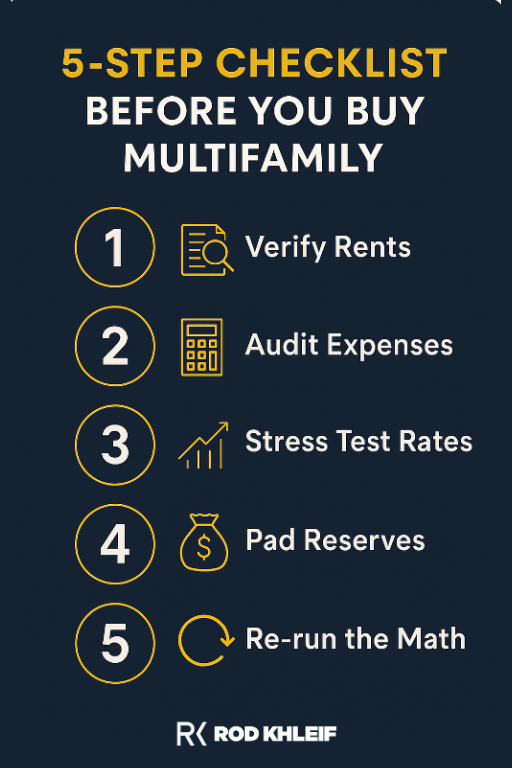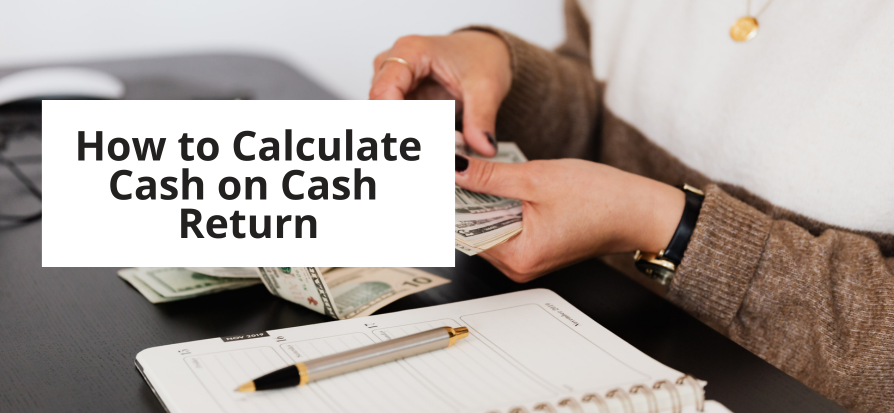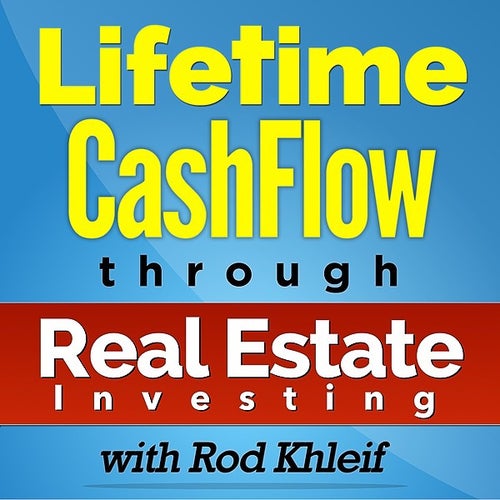The Fast‑Track Guide for First‑Time Multifamily Investors
Calculating returns shouldn’t feel like brain surgery. When I bought my very first property in 1981, I used a handheld calculator, a yellow pad, and a whole lot of guesswork. Today you have better tools and this guide on how to calculate cash on cash return. I’ll walk you through the math, the mindset, and the rookie mistakes to avoid so you can invest with confidence.
TLDR;
Cash‑on‑cash return equals annual pre‑tax cash flow divided by total cash invested. Start with net rental income, subtract operating costs and debt service, then divide that figure by your down payment, closing costs, and capital reserves. The result, expressed as a percentage, shows your yearly cash yield on money actually deployed.
What is Cash on Cash Return?
Cash on cash return (CoC) is an easy way to measure the yearly cash income you earn from your investment. This applies to a property or any asset that makes money. It is calculated before taxes. It shows how quickly you are “recovering” your initial investment through net operating income.
Why Does Cash on Cash Still Matter in 2025
Cash-on‑cash (CoC) tells you how hard your dollars work every single year with no fancy projections or crystal ball. In an environment where rates, rents, and regulations shift fast, cash on cash return is the clearest check on a deal’s viability.
New investors chase flashy “IRR” charts. But cash on cash tells you whether the property feeds you every month. Rising interest rates and tighter lending mean bigger mortgage payments in 2025. Your deal must spit out spendable cash, not just paper profits. HUD’s latest Multifamily Outlook confirms operating expenses rose 5.8 % last year (HUD, 2025). You need a cushion.
How Do You Calculate Cash on Cash Return?
The Cash-On-Cash Return equation is refreshingly simple, which means any error is painfully obvious. Master this math once and you’ll evaluate deals on napkins, flights, or wherever opportunity strikes.
Cash‑on‑Cash Return = (Annual Pre‑Tax Cash Flow ÷ Total Cash Invested) × 100
Annual Pre‑Tax Cash Flow = Net Operating Income (NOI) – Annual Debt Service
Total Cash Invested = Down Payment + Closing Costs + Initial Repairs/Reserves
A Real‑World Example
Theory is great; proof is better. Here’s a live‑ammo scenario that mirrors what beginners see in today’s marketplace. Follow along and you’ll spot the decision points that separate solid deals from money pits.

How to Calculate Cash on Cash Return Step-by-step
-
Find NOI. Rents $120,000; expenses $45,000 → NOI = $75,000.
-
Subtract Debt. Annual mortgage payments $48,000. Cash flow = $27,000.
-
Add Total Cash In. $250k + $25k + $25k = $300,000.
-
Divide and Multiply. $27,000 ÷ $300,000 = 0.09 → 9 % cash‑on‑cash return.
5 Step Checklist Before You Buy
Great returns start long before closing day. Run this checklist every time and you’ll sleep better, your investors will breathe easier, and your lender will view you as a pro.
-
Verify Rents. Call competing properties; demand trailing‑12 statements.
-
Audit Expenses. Insurance, taxes, and repairs creep up fast.
-
Stress‑Test Rates. Model a 1‑point interest bump on your loan.
-
Pad Reserves. Set aside at least $300 per unit, per year.
-
Re‑run the Math. If cash on cash drops below 6 %, renegotiate or walk.

Common Rookie Mistakes
Experience is a brutal teacher and she gives the test before the lesson. Skip the scars by learning where beginners usually stumble.
-
Counting appreciation as cash. Appreciation is gravy, not dinner.
-
Ignoring capital expenditures. Roofs leak when spreadsheets don’t.
-
Underestimating vacancy. Budget at least 5 % even in hot markets.
-
Using fake pro‑formas. Trust real rent rolls, not broker daydreams.
-
Forgetting taxes. Consult a CPA who understands real estate.
Advanced Move: Boosting Your Return
Once you master the basics, it’s time to boost your return from each property. These tactics turn a good deal into a home‑run without taking reckless risks.
-
Raise below‑market rents after light value‑adds. ex. paint, LED lights, smart locks.
-
Refinance once NOI jumps. Pull equity, lower payment, or both.
-
Master rubs (ratio utility billing) to pass water and trash to tenants.
Freddie Mac shows utility bill‑back programs can lift NOI 3–5 % (Freddie Mac Multifamily, 2024). That alone can push cash‑on‑cash from good to great.
Quick Comparison Table
Wondering how CoC stacks up against the cap rate you keep hearing about? Use this snapshot to keep each metric in its lane.
Internal Resources to Dig Deeper
Knowledge compounds faster than money. Dive into these tools and episodes to sharpen your edge between deals.
-
Crunch numbers with my Cap Rate Calculator
-
Learn exactly how to spot value in my Multifamily Syndication Guide
-
Hear investor success stories on the Lifetime Cash Flow Podcast
Key Takeaways
If you remember nothing else, tattoo these points on your investing brain.
Cash‑on‑Cash Is King. It measures real money in your pocket. You need to know how to calculate cash on cash return if you’re going t be investing in multifamily.
Use Real Numbers. Verify income, expenses, and debt terms.
Aim for 8 % or Higher. Anything less deserves a crystal‑clear upside plan.
Protect Liquidity. Keep reserves so surprises don’t kill returns.
Iterate Fast. Recalculate after every change. Include everything like rent bumps, refinance, rehab.
Cash on Cash Return FAQ
What is cash-on-cash return?
Cash-on-cash return is a metric used in real estate investing to measure the annual return an investor earns on the actual cash invested into a property. Unlike cap rate, which looks at a property’s value, cash-on-cash return focuses on how much money you’ve personally put into the deal versus how much cash flow you’re getting back each year. For example, if you invest $100,000 of your own money into a property and it generates $10,000 in annual pre-tax cash flow, your cash-on-cash return is 10%.
How is cash-on-cash return calculated?
The formula is straightforward:
Annual Pre-Tax Cash Flow ÷ Total Cash Invested = Cash-on-Cash Return.
Cash flow is usually calculated after all operating expenses, property management, and debt service are paid, but before taxes. Total cash invested includes your down payment, closing costs, and any renovation or upfront expenses you put into the property.
Why is cash-on-cash return important for investors?
It’s one of the most practical metrics for investors because it tells you how hard your money is working. While appreciation and tax benefits are important, many investors prioritize ongoing cash flow. Cash-on-cash return shows whether a deal meets your income goals, especially if you’re looking to replace a salary, achieve financial independence, or measure performance against other potential investments like stocks or bonds.
What is considered a “good” cash-on-cash return?
It depends on the market, the property type, and your risk tolerance. In many U.S. markets, investors aim for at least 8–12% cash-on-cash return on multifamily or small rental properties. In hotter, more competitive markets, you might see lower returns (5–7%), while riskier or value-add deals in emerging markets could offer 12–20% or more.
What factors affect cash-on-cash return?
Several variables directly influence the return:
-
Financing terms: A lower interest rate or longer amortization can boost cash flow.
-
Operating expenses: High taxes, insurance, or maintenance costs eat into returns.
-
Vacancy rate: Fewer paying tenants lowers income and reduces return.
-
Rent growth: Properties with strong demand and increasing rents tend to improve returns over time.
-
Upfront investment: The more you invest upfront (such as a larger down payment or costly renovations), the harder it is to achieve a high return percentage.
How is cash-on-cash return different from ROI?
ROI (Return on Investment) measures total return over time, including appreciation, loan paydown, and tax benefits. Cash-on-cash return looks only at annual pre-tax cash flow compared to cash invested. It’s a short-term, income-focused metric, while ROI is a broader, long-term performance measure.
Can cash-on-cash return change over time?
Yes, it often does. Rents may rise, expenses may fluctuate, and mortgage payments can change if you refinance. A property might start at 7% cash-on-cash return but increase to 10%+ as rents grow and the mortgage remains fixed. Investors often look for value-add opportunities where they can force appreciation and boost rental income, leading to stronger cash-on-cash returns after renovations or repositioning.
Is cash-on-cash return the only metric investors should use?
No. While it’s extremely useful for measuring short-term performance, you should also consider cap rate, IRR (internal rate of return), equity multiple, and market fundamentals. Cash-on-cash is best for answering: “How much money is my cash making me right now?” But it doesn’t account for long-term value growth, tax savings, or loan amortization.
How can I improve cash-on-cash return on a property?
You can increase return by raising rents, lowering expenses, refinancing into better loan terms, or negotiating seller concessions to reduce upfront investment. Creative financing strategies, such as partnering with investors or seller financing, can also reduce your out-of-pocket costs and raise the cash-on-cash return percentage.
Should new investors rely heavily on cash-on-cash return?
Yes, but with context. For first-time investors, cash-on-cash return is a simple, tangible way to evaluate deals. It helps you avoid buying properties that look good on paper but don’t produce real income. At the same time, you don’t want to ignore appreciation potential or tax advantages, which may justify a slightly lower cash-on-cash return if the long-term upside is strong.
Disclaimer: This article was written with the help of AI and reviewed by Rod’s team. Always consult a licensed professional.
Ready to Accelerate?
Subscribe to the Lifetime Cash Flow Podcast for weekly deep dives.
Seats are filling fast for my next Multifamily Bootcamp. Claim yours now → www.rodkhleif.com/bootcamp.
Let’s build lifetime cash flow together!
-Rod Khleif




